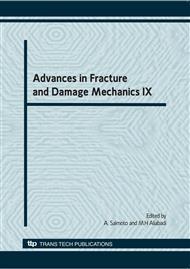p.65
p.69
p.73
p.77
p.81
p.85
p.89
p.93
p.97
Wedge-Splitting Test – Determination of Minimal Starting Notch Length for Various Cement Based Composites Part II: Crack and Notch Fracture Mechanics Approaches
Abstract:
The paper focuses on the geometrical proportions of cube-shaped quasi-brittle specimens subjected to a wedge-splitting test (WST). The minimal/optimal initial crack/notch length for successful performance of WST on these specimens is studied numerically (ANSYS). This second part of the paper treats the problem asymptotically, i.e. from the point of view of a very fine grained silicate composite material with negligible characteristic length which describes the level of the material brittleness (i.e. brittle). The problem of competition of the crack initiation point between the notch tip and the groove corner in the load-imposing area of the specimen is solved using theories of both linear elastic fracture mechanics and fracture mechanics of generalized singular stress concentrators. The numerically obtained crack/notch length is compared to results of numerical simulations using cohesive crack model reported in the first part of the paper. The minimal notch length is recommended.
Info:
Periodical:
Pages:
81-84
Citation:
Online since:
November 2010
Authors:
Price:
Сopyright:
© 2011 Trans Tech Publications Ltd. All Rights Reserved
Share:
Citation:


